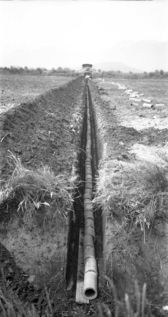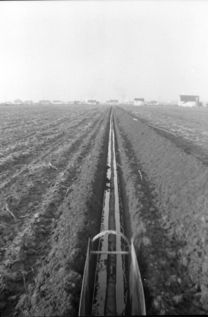Ditch Digging
The first photograph shows Hans Hoffmann’s ditcher on a truck in front of his shop ready to go, the second image is of the ditcher in the background on Sea Island, and the last image is of ditch tiles with a building in the background. All the photographs are from 1950s. In the early years of his career, Hans' innovative skills helped him imagine and build three effective trenching machines, two on wheels and one on a track, that were vital for digging ditches and draining land in Pitt Meadows and around the lower mainland. This invention made the lives of local farmers much easier, because previously, this work had to be done by hand. Within four months time, thirty miles of tile drain were laid in the Pitt Polder area. "He worked all over the Fraser Valley with them, I can still see him working out there, he had a little bulldozer besides that, I don't know whatever happened to that, but he would close the ditch back up with that bulldozer. So, tile was mostly from Haney Brick and Tile, some came from Abbotsford, I can't remember what the name of that outfit was, but they made mostly the same product. The machines were trucked across the Fraser Valley to wherever he needed to be working… the ditcher it was used to drain farm lands, and it would use orange tile, mainly in the farmlands, sometimes in the wetter areas they would use a larger tile, six inch or eight inch, depends on how much water you had to get rid of. He would take level shots with his transit on the field before he would start, then he would slope the water, the tiles, to slope one way on the field, or both ways if it was a long field, he'd raise the centre of it up so he had a water level up machine so he could tell exactly how deep he was going and he had markers on the end of the field where he was gauging from. It was all done by one single engine. All he had was one board to stand on and one board to sit on if he got really tired. The tile was laid in a form; the tile would slide down and automatically lay down in the ditch so nobody had to work down in the bottom of the ditch where there was water for instance or mud. Then a day or two later they would come along with the little bulldozer and push the dirt back into the ditch and always leave a hump in the field, the dirt would settle on its own. They wouldn't compact it because it would do it on its own. Over time, within a year, it would be level, the soil would settle." (Carl Jong, Interview)
Details:
Latitude: 49.2256864253150
Longitude: -122.68978966915
Direct Link: https://www.pittmeadowsmuseum.com/locations/ditch-digging




